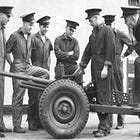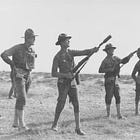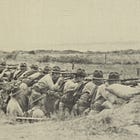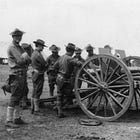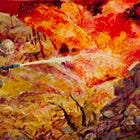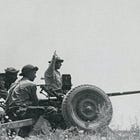H&S Company of the Marine Infantry Regiment (28 March 1941)
Battalion: An Organizational Study of United States Infantry
The estate of the late John Sayen has graciously allowed the Tactical Notebook to serialize his study of the organizational evolution of American infantry battalions. Guides to other parts of this (very long) series can be found in the section marked “For Further Reading.”
On 28 March 1941, Headquarters, US Marine Corps approved a set of establishments for the infantry regiments of the Fleet Marine Force. While these “D-series” tables of organization borrowed much from the structure adopted by the Army on 1 October 1940, they differed greatly where the provision of motor vehicles were concerned.1 Thus, for example, where the Army infantry battalion rated twenty-nine trucks, the Marine infantry battalion relied entirely on hand carts.
Marine parsimony in the realm of motor transport reflected two assumptions. The first was the belief that space on amphibious transports would be limited. The second was the presumption that Marines would land at beaches close to the places where they would fight.
Like its Army counterpart, the Marine infantry regiment of 28 March 1941 was formed on a triangular frame. That is, it consisted of three battalions and a small number of stand-alone companies. However, where the Army regiment had three autonomous companies, the Marine unit had but two: a H&S (headquarters and service) company and a weapons company.2
With a total strength of 124, the H&S company of the Marine regiment rated far fewer people than either the headquarters company (173 officers and men) or the service company (152 officers and men) of the Army regiment. This difference resulted from the absence of a motor transport element in the Marine H&S company and the fact that, with 121 soldiers, the Army communications platoon employed three times as many people as the 40-man communications platoon of the Marine Corps regiment.
Articles about the Marine Infantry Regiment of 28 March 1941
Guides to Battalion: An Organizational Study of United States Infantry
To Share, Subscribe, or Support:
In researching early establishments for Marine divisions, the author found no trace of any tables of organization marked “A-series,” “B-series,” or “C-series.” He therefore speculated that those names had been used to designate draft tables that had been discussed, but not adopted.
A subsequent article in this series will describe the regimental weapons company.






